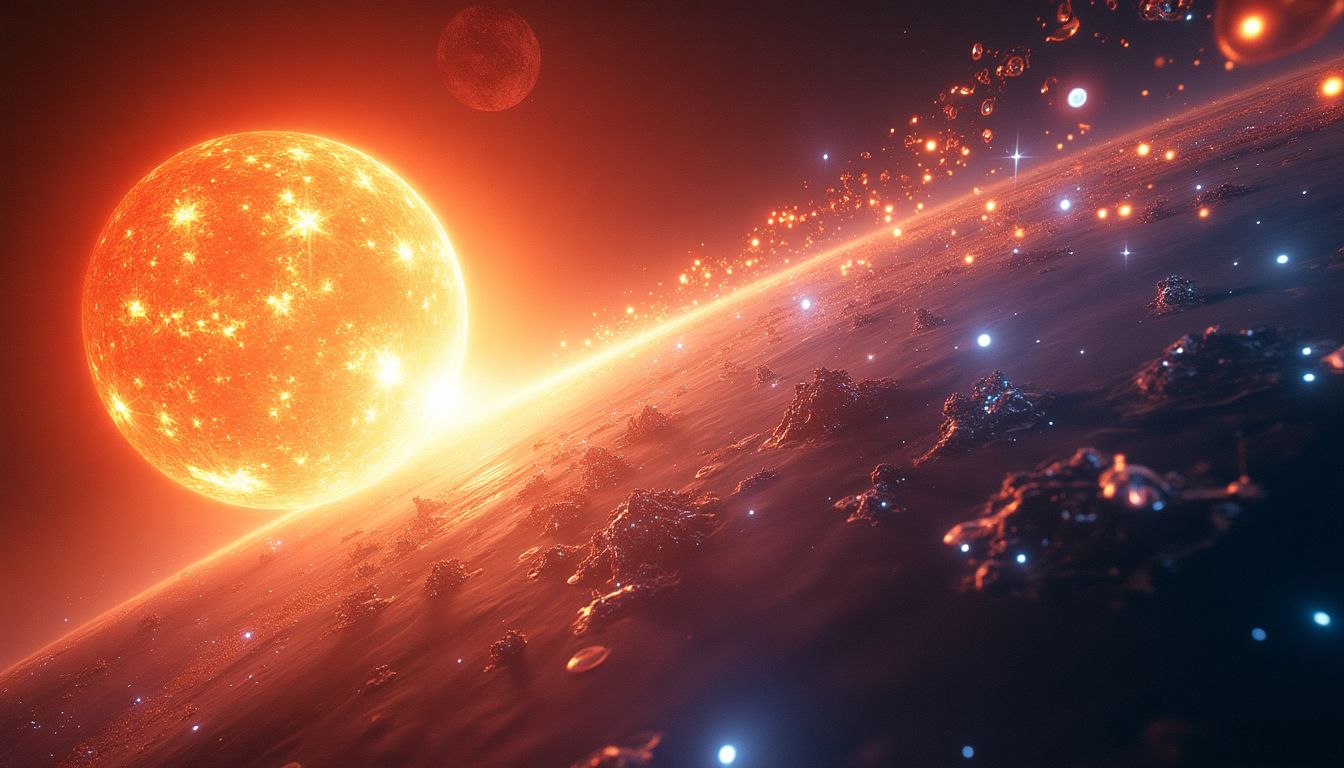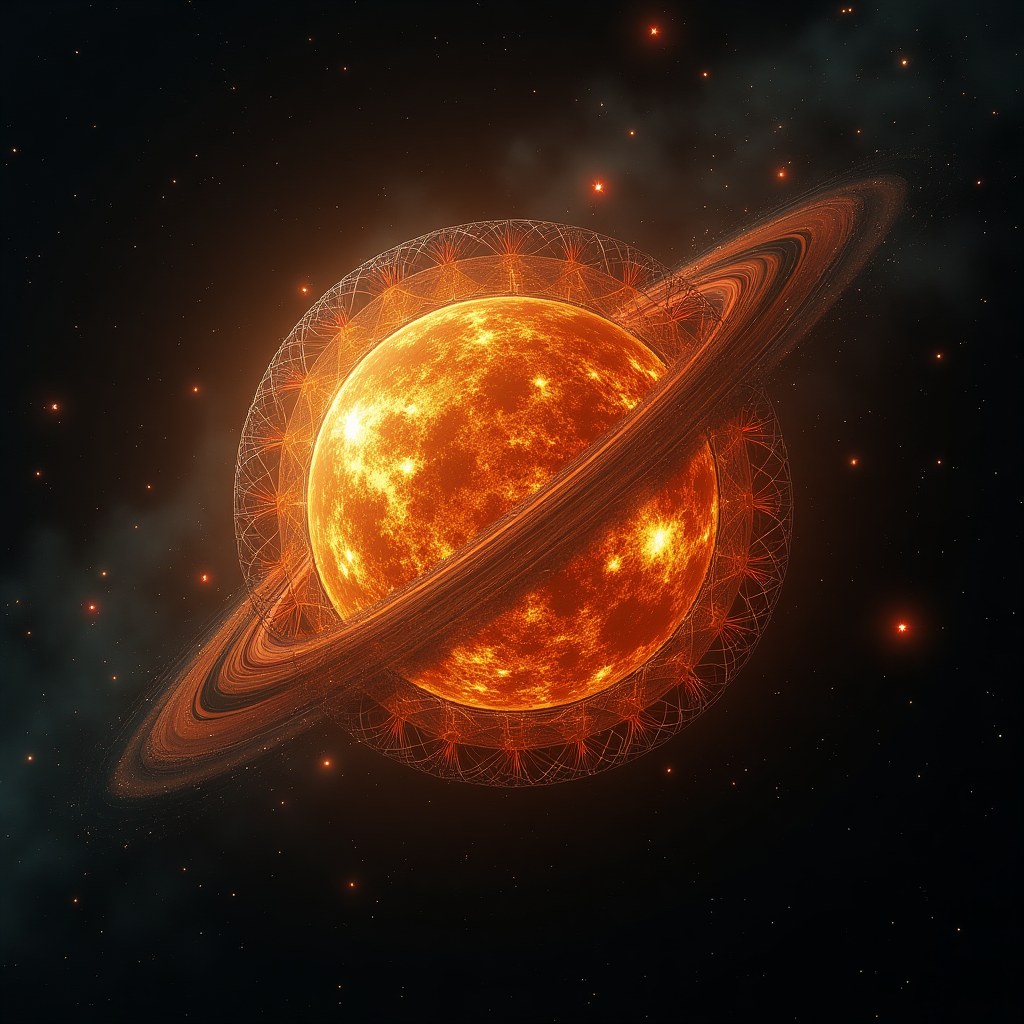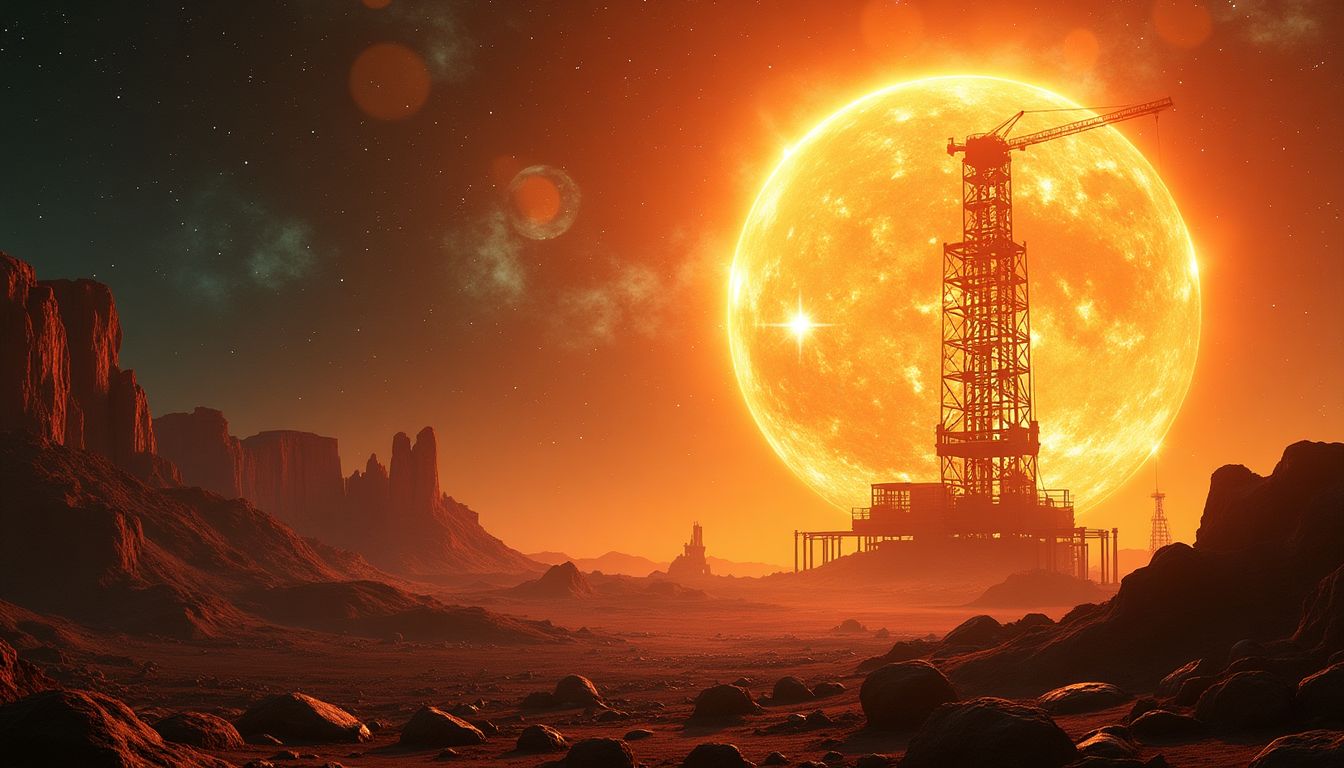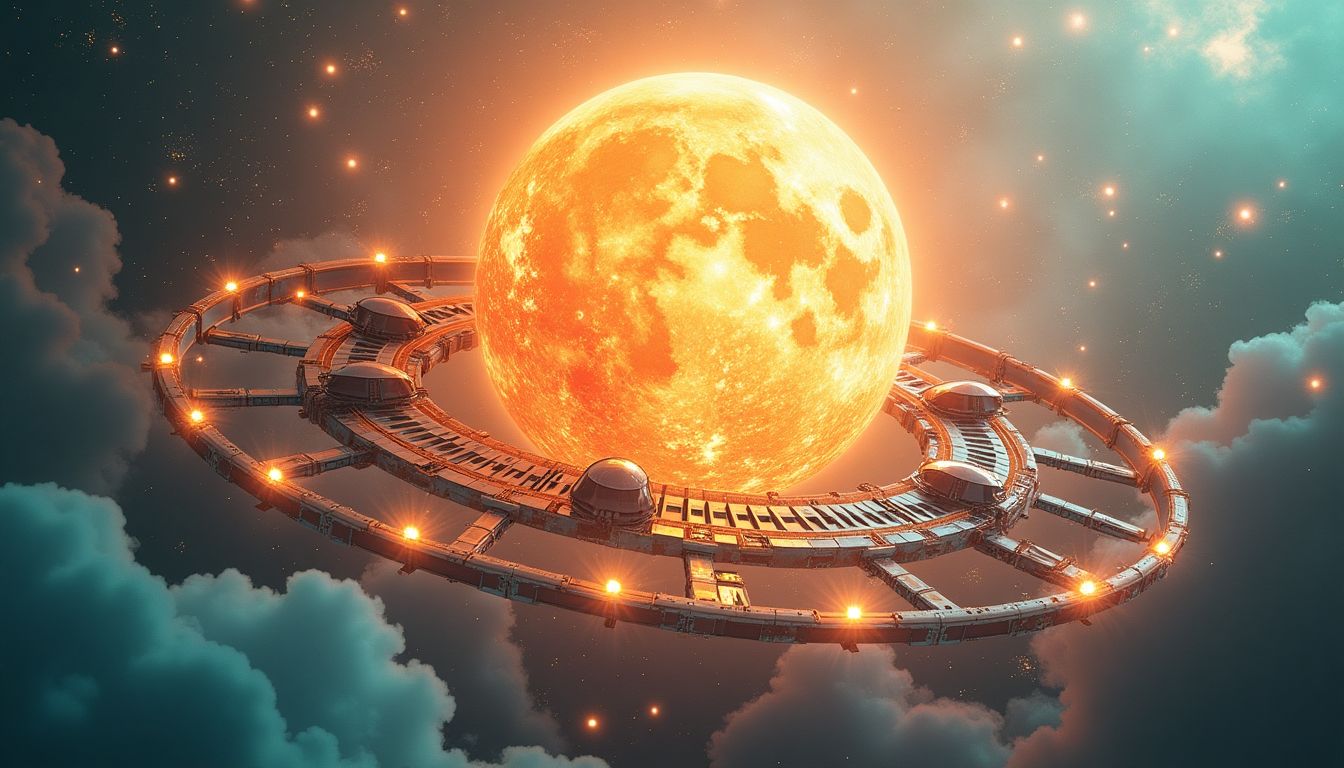What if humanity could tap into the full energy output of the Sun, powering cities, industries, and even interstellar travel? This isn’t just a plot from a sci-fi movie—it’s the promise of a Dyson Sphere, a megastructure so vast it could encapsulate a star to capture its energy. Building something on this scale seems impossible, right? Not if we bring artificial intelligence (AI) into the mix. AI-driven machines could be the key to constructing these colossal structures, transforming how we think about energy and our place in the universe.
The idea of a Dyson Sphere was first proposed by physicist Freeman Dyson in 1960 as a solution for advanced civilizations' energy needs. Today, with breakthroughs in AI, robotics, and space exploration, this concept is no longer just a daydream. Visionaries like Michio Kaku and Neil deGrasse Tyson have discussed how such megastructures could propel humanity into a Type II civilization on the Kardashev Scale. But how would we actually build one? Spoiler: it’s not as simple as ordering parts from IKEA.
This article dives into the science, challenges, and potential solutions for building a Dyson Sphere, with a special focus on how AI could make this gargantuan project possible. By the end, you’ll have a roadmap for turning this futuristic vision into reality—or at least understand why it’s worth dreaming about.
1. The Concept of a Dyson Sphere: What Is It and Why Build One?
1.1 What Is a Dyson Sphere?
A Dyson Sphere is a theoretical megastructure that surrounds a star to capture its energy output. Think of it as a giant solar panel wrapped around the Sun, except it’s not just one solid piece. There are different types of Dyson Spheres, like a Dyson Swarm (a cloud of solar-collecting satellites), a Dyson Bubble (a network of statites held in place by solar wind), and a Dyson Shell (a solid sphere encasing the star).
The concept was first introduced by Freeman Dyson in 1960. He wasn’t proposing we build one—he was thinking about how advanced civilizations might harness energy. Since then, the idea has captured the imagination of scientists and sci-fi fans alike, appearing in everything from Star Trek to popular culture.
1.2 Why Build a Dyson Sphere?
Why go through the trouble of building something so massive? For starters, it’s all about energy. As our civilization grows, so does our energy appetite. A Dyson Sphere could capture 100% of a star’s energy output, providing enough power to sustain entire galaxies. It’s the ultimate upgrade for a Type I civilization (like us) striving to become a Type II civilization on the Kardashev Scale.
Building a Dyson Sphere isn’t just about energy—it’s about survival and expansion. With unlimited energy, we could power interstellar travel, terraform planets, and ensure humanity’s long-term survival. Plus, let’s be honest, it would be the most epic construction project in history.
1.3 Challenges of Building a Dyson Sphere
Of course, building a Dyson Sphere isn’t a walk in the park. The sheer scale is mind-boggling. We’re talking about a structure that could span millions of kilometers. Then there’s the issue of materials. We’d need trillions of tons of metal, which might require mining entire asteroids. And let’s not forget the engineering challenges—like keeping the structure stable, managing extreme temperatures, and avoiding collisions with planets or other celestial bodies. It’s like building a skyscraper, except the skyscraper is as big as a solar system and the hardware store is in another galaxy.
2. The Role of AI in Space Construction
2.1 AI as the Ultimate Problem-Solver
Artificial intelligence is like the Swiss Army knife of space construction. It can process mountains of data faster than you can say “Dyson Sphere” and come up with solutions that leave even the smartest humans scratching their heads. Take NASA’s Mars rovers, for example. These clever machines, like Perseverance, use AI to navigate the Red Planet’s rugged terrain and make decisions on the fly. If AI can handle Mars, it’s not a stretch to imagine it managing the construction of a megastructure around our Sun.
But AI isn’t just about crunching numbers. It’s about optimization. Think of it as the ultimate project manager, ensuring every piece of the puzzle fits perfectly. From calculating the best angles for solar panels to predicting potential structural weaknesses, AI can do it all. And the best part? It doesn’t need coffee breaks.
2.2 AI-Driven Robotics for Construction
If you thought autonomous cars were cool, wait until you hear about autonomous construction robots. These little geniuses could be the backbone of Dyson Sphere construction. Picture a swarm of robots, each with a specific task, working in perfect harmony. Some could be mining asteroids for precious metals, while others assemble the giant solar panels needed for the Sphere. And let’s not forget the maintenance bots, tirelessly patrolling the structure to fix any issues that arise.
One of the most exciting developments in this field is swarm intelligence. Inspired by nature—like how bees work together to build a hive—this technology allows robots to communicate and coordinate their efforts without human intervention. It’s like a well-oiled machine, but with a lot more beeping.
2.3 AI in Resource Management
Building a Dyson Sphere is going to require a ton of resources. And by a ton, I mean trillions of tons. Where are we going to get all that material? The answer lies in our cosmic backyard. Asteroids, moons, and even space debris could provide the metals and other materials needed for construction.
But how do we find and harvest these resources efficiently? Enter AI. With its ability to analyze vast amounts of data, AI can identify the most promising mining sites and optimize the extraction process. It can also manage the logistics of transporting materials from one location to another, ensuring everything arrives where it’s needed, when it’s needed. It’s like Amazon Prime, but for space construction.
3. Materials and Energy Requirements
3.1 Sourcing Materials
So, you’re probably wondering: what’s the shopping list for a Dyson Sphere? First up, we’re going to need a lot of metal. Think iron, nickel, and aluminum—the kind of stuff you’d find in abundance on asteroids. NASA’s OSIRIS-REx mission has already shown that we can collect samples from asteroids, and with AI-driven mining robots, we could scale this up to an industrial level.
But it’s not just about mining. We can also recycle space debris and defunct satellites, turning them into valuable construction materials. It’s a win-win: we clean up space and get the resources we need. Plus, it’s the ultimate example of turning trash into treasure.
3.2 Energy for Construction
Building a Dyson Sphere is going to require a massive amount of energy. Fortunately, we have a nearly limitless source right in front of us: the Sun. Solar power will be our primary energy source, powering everything from mining robots to construction machinery.
But what if we need a backup? That’s where nuclear fusion comes in. While we’re not quite there yet, fusion has the potential to provide a steady, powerful energy source that could supplement solar power. Imagine a construction site where the workers are powered by miniature stars—sounds like science fiction, but it could be our reality.
3.3 Transporting Materials
Once we’ve mined the materials, we need a way to get them to the construction site. This is where space elevators and mass drivers come into play. Space elevators are essentially giant cables that stretch from Earth’s surface into space, allowing us to transport materials without the need for rockets. Mass drivers, on the other hand, use electromagnetic force to launch materials into space at high speeds.
AI will play a crucial role in optimizing these transportation systems, ensuring that materials are delivered efficiently and safely. It’s like managing a cosmic highway, but with a lot more math and a lot fewer traffic jams.
4. Engineering Challenges and Solutions
4.1 Structural Integrity
Think about building a structure so massive it could wrap around the Sun. Sounds impossible, right? Well, one of the biggest hurdles is ensuring the Dyson Sphere doesn’t collapse under its own weight or get fried by the Sun’s intense heat. The materials used must be able to withstand extreme temperatures, radiation, and gravitational forces. Here’s where AI comes in. By running thousands of simulations, AI can help design materials that are both lightweight and incredibly strong. Think of it like designing a futuristic version of graphene or carbon nanotubes—materials that are both durable and flexible. But even with the best materials, structural integrity remains a challenge. AI can simulate stress tests, predicting how the structure will behave under different conditions and tweaking the design to avoid catastrophic failures.
4.2 Orbital Mechanics
Imagine trying to keep trillions of components in perfect orbit around the Sun. It’s like herding cats, but in space. Each piece of the Dyson Swarm—whether it’s a satellite or a solar panel—needs to stay in a stable orbit without crashing into others. AI can solve this by calculating precise trajectories and adjusting them in real-time. Think of it as a cosmic traffic controller, ensuring every piece stays on its designated path. AI algorithms can also predict collisions and reroute components before disaster strikes. This isn’t just science fiction—NASA already uses AI for similar tasks in space missions like the Mars rovers.
4.3 Thermal Management
Now, let’s talk about heat—and not the kind you feel on a summer day. The Sun pumps out enough energy to vaporize most materials, so cooling the Dyson Sphere is critical. AI can design systems that redistribute heat efficiently, preventing the structure from melting. One idea is to use heat radiators or even redirect excess energy to power other parts of the Sphere. AI can also monitor temperature fluctuations and adjust cooling mechanisms in real-time. It’s like having a thermostat for the entire Solar System.
5. Ethical and Societal Implications
5.1 Environmental Impact
Building a Dyson Sphere isn’t just an engineering feat—it’s a planet-sized ethical dilemma. What happens to Earth and the rest of the Solar System when we start harvesting the Sun’s energy on such a massive scale? Could it disrupt ecosystems or even alter Earth’s climate? These are questions we can’t ignore. AI can help mitigate risks by modeling potential environmental impacts and suggesting ways to minimize harm. For example, AI could ensure that the Dyson Sphere doesn’t block too much sunlight, keeping Earth’s ecosystems intact. But even with AI, we’ll need global agreements to address these concerns.
5.2 Economic Considerations
Let’s face it: building a Dyson Sphere won’t be cheap. We’re talking trillions of dollars—or more. Where will this money come from, and who will foot the bill? Here’s where collaboration becomes key. Nations, corporations, and even private investors could pool resources to fund the project. AI can optimize costs by finding the most economical ways to source materials and manage construction. But there’s also the question of who benefits. Will the energy harvested by the Dyson Sphere be shared equitably, or will it create new divides between rich and poor?
5.3 Philosophical Questions
Finally, building a Dyson Sphere forces us to ask some big questions about humanity’s role in the universe. Are we entitled to harness the energy of our star? What does it mean to become a Type II civilization? AI can’t answer these questions for us, but it can help us explore the possibilities. For example, AI could simulate different scenarios, showing us the long-term consequences of our actions. Ultimately, the decision to build a Dyson Sphere isn’t just about science and technology—it’s about who we are and what we want to become.
6. AI Solutions: How Would AI Tackle This Issue?
6.1 Step-by-Step AI Approach
Building a Dyson Sphere is no small feat, but AI could be the game-changer that makes it possible. Here’s how AI would tackle this monumental task:
- Data Collection: AI would begin by analyzing astronomical data to identify the most optimal locations and materials. Using machine learning algorithms, it would sift through petabytes of data from telescopes like the James Webb Space Telescope and ESO to pinpoint asteroids rich in metals and other resources.
- Design Optimization: AI would generate thousands of design iterations, simulating everything from structural integrity to thermal management. Tools like Autodesk and Ansys would be enhanced with AI to create the most efficient and feasible designs.
- Resource Allocation: AI would coordinate mining, manufacturing, and transportation efforts. Autonomous drones, like those developed by SpaceX, would be deployed to mine asteroids, while AI-driven logistics systems would ensure materials are delivered where they’re needed most.
- Construction Management: AI would oversee autonomous robots and swarm systems for assembly. Companies like Boston Dynamics and Blue Origin would provide the robotics needed for this massive undertaking.
- Maintenance and Upgrades: AI would continuously monitor the structure, implementing repairs or improvements as needed. This would involve advanced robotics with self-repair capabilities, ensuring the Dyson Sphere remains operational for centuries.
6.2 Scientific and Technological Innovations
AI would drive several key innovations to make the Dyson Sphere a reality:
- Machine Learning Algorithms: These would be used for predictive modeling, allowing AI to anticipate and mitigate potential issues before they arise.
- Quantum Computing: Quantum computers, like those being developed by IBM and Google, would solve complex optimization problems that are currently beyond the reach of classical computers.
- Advanced Robotics: Robots with self-repair capabilities would be essential for maintaining the Dyson Sphere. These robots would be equipped with AI to diagnose and fix issues autonomously.
6.3 Collaboration with Human Experts
AI wouldn’t work in isolation; it would collaborate closely with human experts:
- Astrophysicists: Experts like Neil deGrasse Tyson and Michio Kaku would provide the scientific insights needed to guide AI’s efforts.
- Engineers: Teams from institutions like MIT and Caltech would work alongside AI to refine designs and solve engineering challenges.
- Ethicists: Ethical considerations would be addressed by experts in the field, ensuring that the project aligns with humanity’s values and long-term goals.
6.4 Action Schedule/Roadmap
Here’s a detailed roadmap for building a Dyson Sphere, leveraging today’s technology and AI:
| Timeline | Action | Key Players |
|---|---|---|
| Day 1 | Assemble a global task force of scientists, engineers, and AI experts. | NASA, ESA, SpaceX |
| Day 2 | Launch initial AI simulations to model Dyson Sphere designs. | Google DeepMind, IBM Quantum |
| Week 1 | Begin asteroid prospecting missions using AI-driven drones. | Blue Origin, Planetary Resources |
| Week 2 | Develop prototypes for autonomous mining robots. | Boston Dynamics, Honeywell |
| Month 1 | Establish a space-based manufacturing facility. | Lockheed Martin, Northrop Grumman |
| Month 2 | Test AI algorithms for orbital mechanics and collision avoidance. | MIT, Caltech |
| Year 1 | Deploy the first swarm of construction robots. | SpaceX, Blue Origin |
| Year 1.5 | Begin assembly of the Dyson Swarm’s initial components. | NASA, ESA |
| Year 2 | Achieve 10% completion of the Dyson Swarm, with full energy output projections. | Google DeepMind, IBM Quantum |
The Dawn of a New Era: Humanity’s Leap to a Type II Civilization
The construction of a Dyson Sphere is not just a scientific endeavor; it’s a testament to humanity’s ingenuity and ambition. By harnessing the full energy output of the Sun, we would secure our place as a Type II civilization on the Kardashev Scale, capable of interstellar travel and colonization. This project would require unprecedented levels of collaboration, innovation, and determination, but the rewards are beyond measure.
Imagine a future where energy is no longer a limiting factor, where humanity thrives across the galaxy, and where our descendants look back at this moment as the dawn of a new era. The integration of AI into this monumental task offers a pathway to overcoming the immense challenges we face. From data collection and design optimization to construction management and maintenance, AI would be the driving force behind this historic achievement.
But this is not just about technology; it’s about vision. It’s about daring to dream big and taking the necessary steps to turn those dreams into reality. The journey to building a Dyson Sphere will be long and arduous, but it’s a journey worth taking. As we stand on the brink of this new frontier, let us embrace the challenges and opportunities that lie ahead, and let us work together to build a future that is as bright as the stars themselves.
What do you think? Is building a Dyson Sphere within our reach, or is it a pipe dream? Share your thoughts in the comments below, and don’t forget to subscribe to our newsletter for more insights into the future of technology and space exploration. Become a permanent resident of iNthacity: the "Shining City on the Web", and join the conversation about humanity’s next great leap.
FAQ
1. What is a Dyson Sphere?
A Dyson Sphere is a huge structure that could surround a star, like our Sun, to collect its energy. The idea was first proposed by physicist Freeman Dyson in 1960. It sounds like science fiction, but it’s a real concept scientists are exploring to solve our future energy needs.
2. Why is AI essential for building a Dyson Sphere?
Building a Dyson Sphere is a massive project that would require solving incredibly complex problems. AI can help by:
- Designing the best structure.
- Managing millions of robots for construction.
- Figuring out how to get materials from asteroids and other places in space.
3. How long would it take to build a Dyson Sphere?
With today’s technology, it could take hundreds or even thousands of years. But with advancements in space exploration and AI, we might be able to speed up the process significantly.
4. What materials are needed to build a Dyson Sphere?
We’d need trillions of tons of materials like metals and heat-resistant alloys. These could be mined from asteroids or moons, or even recycled from old satellites and space debris.
5. What are the risks of building a Dyson Sphere?
Some risks include:
- Structural failure due to extreme heat or radiation.
- Environmental impacts on the Solar System.
- Ethical questions about whether we should harness a star’s energy.
6. Who would lead the project to build a Dyson Sphere?
It would likely be a global effort involving scientists, engineers, and organizations like NASA, ESA, and companies like Blue Origin and SpaceX. Universities like MIT and Caltech would also play a key role in research.
7. How would we get the energy from a Dyson Sphere to Earth?
We could use advanced technology like wireless energy transmission or space-based power stations to send the energy back to Earth. This is still a developing field, but scientists are already working on it.
8. Could a Dyson Sphere harm the Sun?
No, a Dyson Sphere wouldn’t harm the Sun. It would only capture the energy the Sun already emits. The Sun would keep shining as it always has.
9. What would a Dyson Sphere mean for humanity?
Building a Dyson Sphere would be a huge step for humanity. It could give us access to almost unlimited energy, allowing us to explore the stars and support a growing population. It would also mark our transition to a Type II civilization on the Kardashev Scale.
10. Is this just a theory, or could it really happen?
While it sounds like something from a movie, the idea is based on real science. With advancements in AI, robotics, and space travel, building a Dyson Sphere could become possible in the future. It’s still far off, but it’s not impossible.
Wait! There's more...check out our gripping short story that continues the journey: The Shattered Swarm
Disclaimer: This article may contain affiliate links. If you click on these links and make a purchase, we may receive a commission at no additional cost to you. Our recommendations and reviews are always independent and objective, aiming to provide you with the best information and resources.
Get Exclusive Stories, Photos, Art & Offers - Subscribe Today!




























Post Comment
You must be logged in to post a comment.